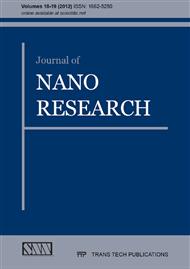[1]
R.E. Gorga, et al., The importance of interfacial design at the carbon nanotube/polymer composite interface, Journal of Applied Polymer Science, 102 (2) (2006) 1413.
DOI: 10.1002/app.24272
Google Scholar
[2]
C. Velasco-Santos, et al., Improvement of Thermal and Mechanical Properties of Carbon Nanotube Composites through Chemical Functionalization, Chemistry of Materials, 15 (23) (2003) 4470.
DOI: 10.1021/cm034243c
Google Scholar
[3]
J.N. Coleman, et al., Improving the mechanical properties of single-walled carbon nanotube sheets by intercalation of polymeric adhesives, Applied Physics Letters, 82 (11) (2003) 1682.
DOI: 10.1063/1.1559421
Google Scholar
[4]
A.S. dos Santos, et al., Morphology, thermal expansion, and electrical conductivity of multiwalled carbon nanotube/epoxy composites, Journal of Applied Polymer Science, 108 (2) (2008) 979.
DOI: 10.1002/app.27614
Google Scholar
[5]
A. Nish, et al., Highly selective dispersion of single-walled carbon nanotubes using aromatic polymers, Nat Nano, 2 (10) (2007) 640.
DOI: 10.1038/nnano.2007.290
Google Scholar
[6]
J. Zhu, et al., Improving the Dispersion and Integration of Single-Walled Carbon Nanotubes in Epoxy Composites through Functionalization, Nano Letters, 3 (8) (2003) 1107.
DOI: 10.1021/nl0342489
Google Scholar
[7]
R. Yerushalmi-Rozen and I. Szleifer, Utilizing polymers for shaping the interfacial behavior of carbon nanotubes, Soft Matter, 2 (1) (2006) 24.
DOI: 10.1039/b513344k
Google Scholar
[8]
T. Fukuda, F. Arai, and L. Dong, Assembly of nanodevices with carbon nanotubes through nanorobotic manipulations, Proceedings of the IEEE, 91 (11) (2003) 1803.
DOI: 10.1109/jproc.2003.818334
Google Scholar
[9]
P.J.F. Harris, Carbon nanotubes and related structures: new materials for the twenty-first century, Cambridge University Press, Cambridge, United Kingdom, (1999).
Google Scholar
[10]
S.J.V. Frankland, et al., The stress-strain behavior of polymer-nanotube composites from molecular dynamics simulation, Composites Science and Technology, 63 (11) (2003) 1655.
DOI: 10.1016/s0266-3538(03)00059-9
Google Scholar
[11]
S.J.V. Frankland, et al., Molecular simulation of the influence of chemical cross-links on the shear strength of carbon nanotube-polymer interfaces, Journal of Physical Chemistry B, 106 (12) (2002) 3046.
DOI: 10.1021/jp015591+
Google Scholar
[12]
M. in het Panhuis, et al., Selective interaction in a polymer-single-wall carbon nanotube composite, Journal of Physical Chemistry B, 107 (2) (2003) 478.
Google Scholar
[13]
S.J.V. Frankland and V.M. Harik, Analysis of carbon nanotube pull-out from a polymer matrix, Surface Science, 525 (1-3) (2003) 103-108.
DOI: 10.1016/s0039-6028(02)02532-3
Google Scholar
[14]
J. Gou, et al., Computational analysis of effect of single-walled carbon nanotube rope on molecular interaction and load transfer of nanocomposites, Composites Part B: Engineering, 36 (6-7) (2005) 524.
DOI: 10.1016/j.compositesb.2005.02.004
Google Scholar
[15]
Z. Liang, et al., Investigation of molecular interactions between (10, 10) single-walled nanotube and Epon 862 resin/DETDA curing agent molecules, Materials Science and Engineering A, 365 (1-2) (2004) 228.
DOI: 10.1016/j.msea.2003.09.032
Google Scholar
[16]
R.W. Friddle, et al., Single functional group interactions with individual carbon nanotubes, Nat Nano, 2 (11) (2007) 692.
Google Scholar
[17]
A.H. Barber, et al., Interfacial fracture energy measurements for multi-walled carbon nanotubes pulled from a polymer matrix, Composites Science and Technology, 64 (15 SPEC ISS) (2004) 2283.
DOI: 10.1016/j.compscitech.2004.01.023
Google Scholar
[18]
M.A. Poggi, L.A. Bottomley, and P.T. Lillehei, Measuring the adhesion forces between alkanethiol-modified AFM cantilevers and single walled carbon nanotubes, Nano Letters, 4 (1) (2004) 61.
DOI: 10.1021/nl0348701
Google Scholar
[19]
L. Xiaojun, et al., Direct measurements of interactions between polypeptides and carbon nanotubes, Journal of Physical Chemistry B, 110 (25) (2006) 12621.
Google Scholar
[20]
A.H. Barber, S.R. Cohen, and H.D. Wagner, Measurement of carbon nanotube-polymer interfacial strength, Applied Physics Letters, 82 (23) (2003) 4140.
DOI: 10.1063/1.1579568
Google Scholar
[21]
M. Rahmat and P. Hubert, Interaction Stress Measurement Using Atomic Force Microscopy: A Stepwise Discretization Method, The Journal of Physical Chemistry C, 114 (35) (2010) 15029.
DOI: 10.1021/jp104993f
Google Scholar
[22]
M. Cho and S. Yang, Multi-scale analysis to characterize mechanical properties of nanoparticle/polymer composites, 49th AIAA/ASME/ASCE/AHS/ASC Structures, Structural Dynamics, and Materials, Schaumburg, IL, (2008).
DOI: 10.2514/6.2008-2101
Google Scholar
[23]
R.W. Haskins, et al., Tight-binding molecular dynamics study of the role of defects on carbon nanotube moduli and failure, Journal of Chemical Physics, 127 (7) (2007) 074708.
DOI: 10.1063/1.2756832
Google Scholar
[24]
T.S. Gates, et al., Computational materials: Multi-scale modeling and simulation of nanostructured materials, Composites Science and Technology, 65 (15-16 SPEC ISS) (2005) 2416.
DOI: 10.1016/j.compscitech.2005.06.009
Google Scholar
[25]
A. Soldera, Energetic analysis of the two PMMA chain tacticities and PMA through molecular dynamics simulations, Polymer, 43 (15) (2002) 4269.
DOI: 10.1016/s0032-3861(02)00240-9
Google Scholar
[26]
J. Tersoff, Modeling solid-state chemistry: interatomic potentials for multicomponent systems, Physical Review B (Condensed Matter), 39 (8) (1989) 5566.
DOI: 10.1103/physrevb.39.5566
Google Scholar
[27]
W. Bao, C. Zhu, and W. Cui, Simulation of Young's modulus of single-walled carbon nanotubes by molecular dynamics, Physica B, 352 (1-4) (2004) 156.
Google Scholar
[28]
B.I. Yakobson, et al., High strain rate fracture and C-chain unraveling in carbon nanotubes, Computational Materials Science, 8 (4) (1997) 341.
DOI: 10.1016/s0927-0256(97)00047-5
Google Scholar
[29]
J.E. Mark, Physical properties of polymers handbook, Second ed, Springer, (2007).
Google Scholar
[30]
G.M. Odegard, et al., Constitutive modeling of nanotube-reinforced polymer composites, Composites Science and Technology, 63 (11) (2003) 1671.
DOI: 10.1016/s0266-3538(03)00063-0
Google Scholar
[31]
S.L. Mayo, B.D. Olafson, and W.A. Goddard, III, DREIDING: a generic force field for molecular simulations, Journal of Physical Chemistry, 94 (26) (1990) 8897.
DOI: 10.1021/j100389a010
Google Scholar
[32]
S.S. Tallury and M.A. Pasquinelli, Molecular Dynamics Simulations of Flexible Polymer Chains Wrapping Single-Walled Carbon Nanotubes, The Journal of Physical Chemistry B, 114 (12) (2010) 4122.
DOI: 10.1021/jp908001d
Google Scholar
[33]
M. Al-Haik, M.Y. Hussaini, and H. Garmestani, Adhesion energy in carbon nanotube-polyethylene composite: Effect of chirality, Journal of Applied Physics, 97 (7) (2005) 074306.
DOI: 10.1063/1.1868060
Google Scholar


